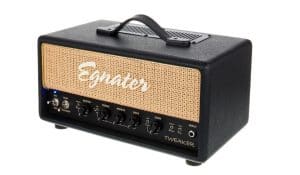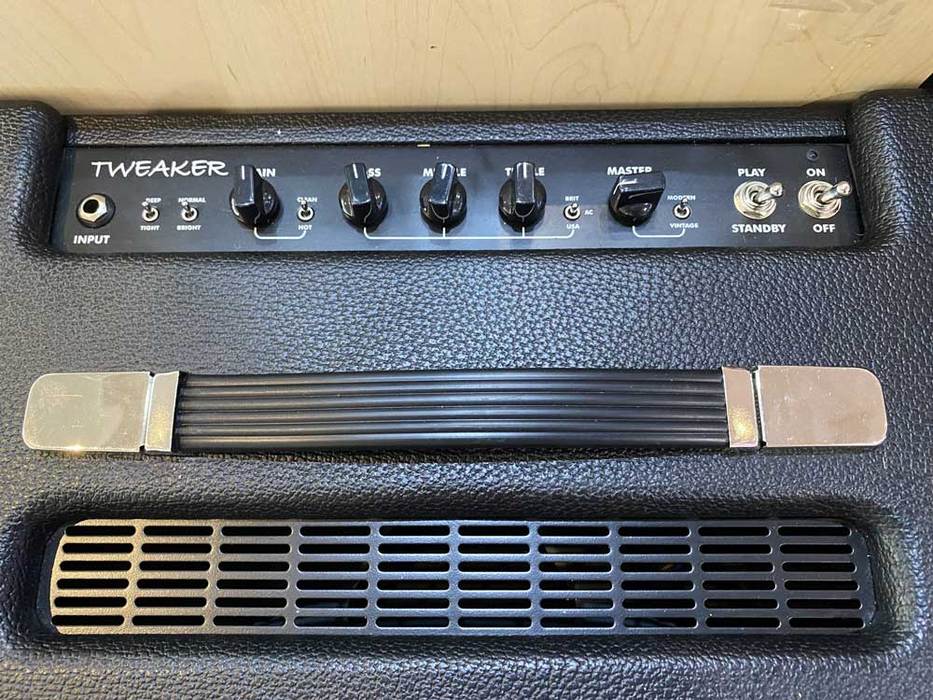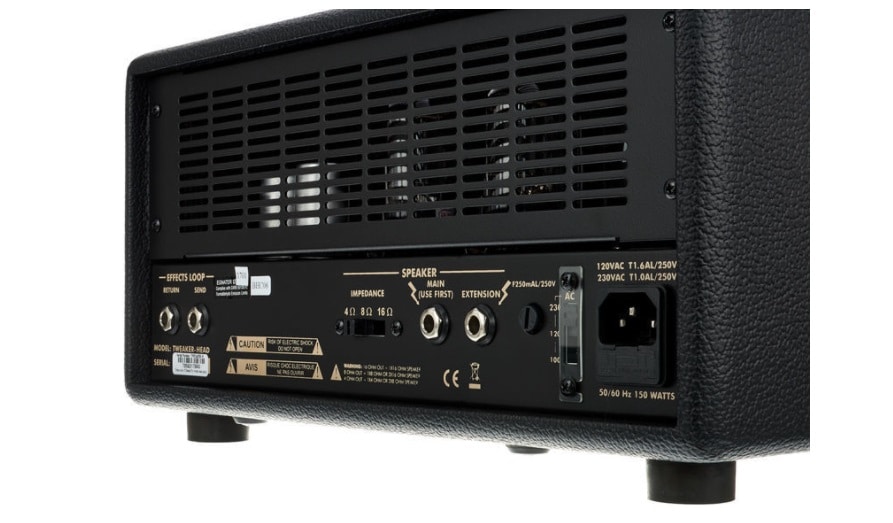Most low-wattage all-valve amps are one-sound wonders, but Egnater Tweaker new baby combo sets out the rewrite the rulebook with options galore.
Buying a ‘big name’ amplifier usually involves buying into a visual and sonic aesthetic. For instance, you’d buy a Marshall if you wanted that great Marshall sound and look. And you wouldn’t expect it to cover Vox or Fender-type sounds. However, for makers whose brand names aren’t indelibly linked with any particular style or music genre. There’s far more scope for technical creativity and tonal variety.

Egnater Tweaker Controls
Table of Contents
It’s just as well, because – whatever you think of them – digital modelling amps have changed our expectations of what an amp should be able to do. There are only so many ways that you can make valves work. Besides speakers, transformers, cabinet design and so forth, the sonic signature of an amp largely depends on the circuit design and the choice of components. In theory you can design an all-valve amp with a range of tones that can rival the modelling brigade. And that seems to be the thinking behind the Egnater Tweaker.
The ‘tweakability’ stems from five small toggle switches on the control panel.
- There’s a Deep/Tight switch that cuts the lowest frequencies at the input stage of the preamp to keep overdriven tones from getting too muddy (the Deep setting is recommended for single-coil guitars and for fattening up clean tones).
- The Bright/Normal switch boosts the high end for extra sparkle on clean sounds and extra bite with distortion. It interacts with the Gain control; Bright is more noticeable with low Gain settings and has no effect with Gain above three o’clock.
- The Hot/Clean switch sets the gain, much like a regular channel switch, and the Vintage/Modern switch modifies the power amp circuit from tonally neutral in Vintage mode to boosted lows and highs in Modern mode.
Features
One added switch really defines what the Tweaker is all about. It’s a three-way switch marked USA, AC and Brit, and it toggles between three classic circuits and three distinctive voicings. USA duplicates the circuits found in Fender’s ‘blackface’ amps, Brit conjures up ‘the stronger lower midrange girth’ that you may associate with Marshall. And AC provides another British voicing that’s Vox amps inspired.

In addition to these switches you get Gain and Master volume controls along with Treble, Middle and Bass. At the rear you’ll find an effects loop, but there are no level controls. The speaker output impedance set to 4, 8 or 16 Ohms, and there’s a speaker extension socket.
The valves number three 12AX7s and two 6V6GTAs in the power stage, so the rectifier is solid state. Cosmetically the Egnater Tweaker is certainly attractive, with a thin ply cabinet, nicely applied black tolex and a ‘basketweave’ front. This is also an example of a mid-price amplifier that comes factory-fitted with a well-regarded bigname speaker – in this case a Celestion G12H-30 70th Anniversary Special Edition.
Sounds
Quoted wattage is hardly a reliable indicator of loudness, so let’s just say this is a very loud 15W amplifier. As far at the Hot/Clean switch goes, ‘Clean’ is a relative term because the Egnater Tweaker can still get mightily overdriven in this mode. However it does deliver loud clean tones, and rather than running with Master flat out and Gain near minimum. The trick to maximising clean headroom is to roll back Master and wind Gain up a little further.
Just how much clean you get depends on the position of the voicing switch. In USA mode it’s bright and clear, with AC producing a softer and sweeter tone with a degree of jangle. Brit has the least amount of clean headroom, but it’s fat and has a delicious growl in the low mids. Regardless of the Tight/Deep setting, the Egnater Tweaker has a tight, solid low end intensity that belies the size of the cab.
Sound setting
No doubt the G12H helps in this regard, but until it is completely broken in you might detect some upper frequency harshness. This brightness also increases as you turn up Gain, but I still found the Bright setting useful at lower volumes. So, in Clean mode the Tweaker takes you from fairly loud clean tones to heavy power amp overdrive with three very effective and distinct voicings.
Moving over to Hot mode, the switches and controls combine to create a range of tones that’s almost overwhelming; if you suffer from tone paranoia, this amp could make your life problematic. The key is learning how the switches combine and interact with the EQ controls. And you’ll need to put the time in.

Although Hot mode delivers some subtle overdrives, at the other end of the Gain scale it’s obvious that Egnater Tweaker is serious about crunch. Of the three simulations, Brit comes closest to meeting our expectations. AC has the brownest tone, especially with Middle boosted and Treble rolled back, and USA. In Modern mode with Deep on, veers towards the glassy presence and brutal lows of a MESA. So, impressive blues and rock, classic metal, fusion, modern metal – all in a small amp that could fool a mic into thinking it’s a half-stack. However, you might agree that P90s and humbuckers cope with the Tweaker’s slight brashness better than F-type single coils.
Verdict
Despite its versatility, the Tweaker is slightly compromised. Because none of the voicing switches are footswitchable it’s only capable of giving one tone at a time. So you can’t easily exploit that versatility when playing live. Unless you use rackmount or line-level effects, the effects loop probably won’t be of much interest. So perhaps the extra valve that buffers the loop could be better utilised for onboard spring reverb duties for plug-in-and-go players. For all its clean capabilities, it’s a rock amp not a sweet-toned Class A honey monster. With an undercurrent of aggression than many players will relish. If touch dynamics and sound-shaping via the guitar controls are your priorities, there might be better amps. But it would be useful for any recording session.

Leave a Reply
You must be logged in to post a comment.